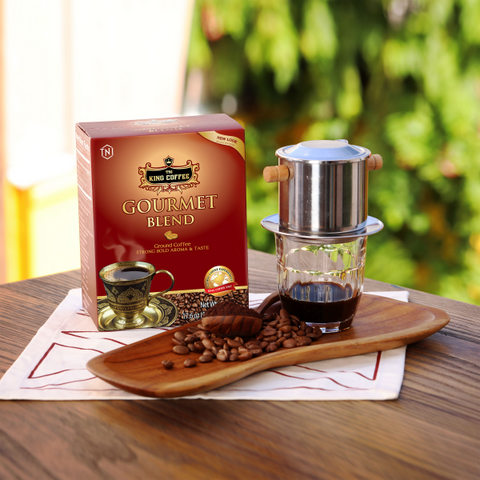What makes Vietnamese iced coffee special?
Recently, the travel magazine The Travel of Canada released a list of 10 countries with the most unique coffee culture in the world, including Vietnam, especially the iced milk coffee made from drip coffee (filter coffee).
So what factors help create the delicious taste of Vietnamese coffee? Let’s find out now!

-
Coffee’s Material
According to Canadian writer Robynne Trueman, in Vietnam, coffee is not just a drink to start a new day like in other countries or a drink that follows a momentary trend. Coffee is something people love to enjoy in the morning, at noon, and even at night, associated with people from all walks of life.
Vietnamese people can drink coffee all day, most of which are made from medium or dark roasted coffee beans, brewed by drip extraction in metal filters.
Without rushing, like machine-made coffee, drip coffee gives a uniquely delicious taste, because each part of coffee is heated and bloomed evenly at the right time. Moreover, waiting for the coffee to drip through the filter is also a way to enjoy, we can have more time to rest, chat, and think about many other things. So even though the coffee machine culture has been introduced to Vietnam for a long time, there are still many coffee shops selling filter coffee, not been significantly affected or replaced.
Thanks to nature’s ideal weather and soil conditions, Vietnam is very convenient for growing, harvesting, and processing coffee. At the top is Robusta coffee, which has a caffeine ratio of 3%-4%, for a strong flavor and is also the most popular. Ranked second is Arabica coffee, which has an iconic aroma of fruits and flowers with low caffeine content (1%-2%), and not too bitter coffee taste. However, with the tendency to enjoy as well as the taste of the younger generation who prefer coffee with a gentler, milder bitter taste, Arabica coffee is gradually reaching the No. 1 position instead of Robusta.

-
Additives
The taste of Vietnamese coffee is not only unique because of the plant variety or roasting method, but also by the accompanying additives.
There are 2 types of additives:
Additives are added in the roasting process and Additives to drinking when preparing finished products.
Additives for processing and roasting coffee
Up to now, no coffee distributor has completely publicized its additive method and formula. Because it takes a lot of effort, time, and expense of the processor to find out which additives are suitable for which coffee, and the dosage.
We can get to know some of the most commonly used additives nowadays (official or unofficial) with the following types:
- Caramel with symbols INS 150a, 150c, 150d: Helps coffee not to be sour when using a high ratio, creates beautiful brown color, and better consistency.
- Table salt: Create a rich flavor.
- Synthetic sweeteners such as INS 950, 951, 955, 954, etc. with the dosage prescribed by the Ministry of Health.
- Synthetic additives improve the structure, making the coffee stronger, such as INS 466, 407, 414, 416, 461, 465, etc.
- Technical butter: Increases the redundancy and color, enhances the strong flavor, and gives the feeling of greasy and fatty coffee.
Depending on the supplier and processor, each processor will have its secret to making the additives mixed properly, making the coffee more delicious, richer, and stronger. This is also a factor for suppliers and coffee brands to compete in the fierce market.

Additives to drink with coffee
With traditional drip coffee (filter coffee), the basic drink additives are extremely simple: Usually only granulated or refined sugar, condensed milk (cream milk), and fresh milk.
Over time, young people have more creativity to enrich the taste of coffee by adding more novel additives such as coconut milk, cocoa, chocolate syrup, cinnamon powder, etc.
-
Quantity
The amount of roasted coffee that is put into each filter to make has almost no clear standard. Vietnamese people often make coffee by feeling, eye, and hand estimation or hands when shoveling coffee powder into the filter. The most popular recipe is to measure the ground coffee so that it takes up to ⅓ of the volume of the filter. Some places have a habit of drinking bland, this ratio is about ¼.
But also, because of this spontaneity and sentimentality have created a unique drip coffee enjoyment culture. People who enjoy will always find a familiar taste when they come to their dear shop, their old place with experienced and familiar brewers. For some people, choosing the right coffee shop can be likened to finding a soulmate.

Hopefully, with a few helpful tips above, you can somewhat understand more about coffee culture as well as the uniqueness of Vietnamese coffee.
Currently, there are many big distributors like TNI King Coffee who are pioneering to bring Vietnamese coffee flavor to foreign markets to spread this unique culture of enjoyment. If you are interested and want to cooperate in franchising, please contact us for more details.
King Coffee - A place to connect elite, creativity and passion
TNI King Coffee Co., Ltd.
Hotline: +1-714-864-3874
Email: info.us@tnicorporation.com
Website: https://us.kingcoffee.com/
